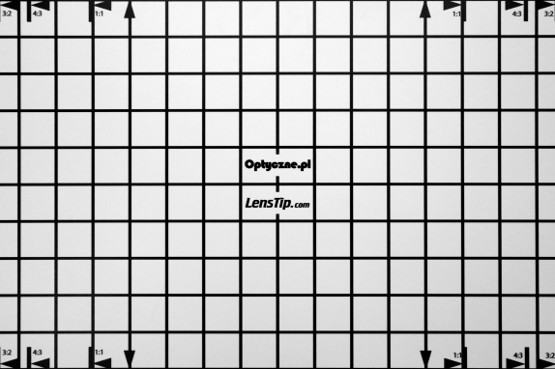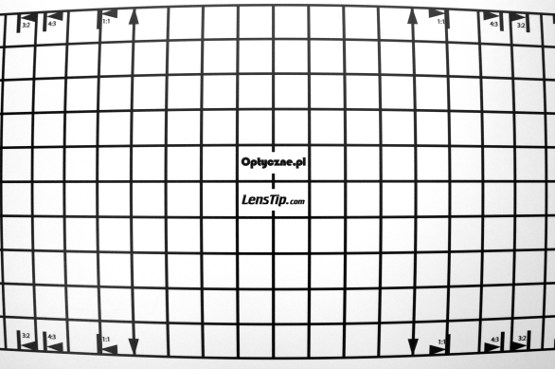Samsung NX 16 mm f/2.4
6. Distortion
Despite blocking the distortion in the „On” position the RAW files, developed with the dcraw program are not distortion corrected, giving us a chance to find out how the optics deals with the problem on its own. It is obvious that the constructors of the lens gave up completely the correction of that optical aberration, leaving that problem to be solved by a camera’s software. In a RAW file we get strong barrel distortion which value we assessed as –5.14%.
The rival Sony 2.8/16 corrected the distortion in a much better way, not showing such huge deformations. In its case we dealt with moustache distortion, though, an aberration very difficult to correct.
Please Support UsIf you enjoy our reviews and articles, and you want us to continue our work please, support our website by donating through PayPal. The funds are going to be used for paying our editorial team, renting servers, and equipping our testing studio; only that way we will be able to continue providing you interesting content for free. |
- - - - - - - - - - - - - - - - - - - - - - - - - - - - - - - - - - - - - - - - - - - - - - - -
It’s worth reminding here that the Samsung NX is not the only system which decided not to correct the distortion by the optics. The Micro 4/3 system presents exactly the same approach – its wide-angle lenses show huge barrel distortion, automatically corrected by the software. You should remember, though, that images after such correction have a significantly narrower angle of view. If you want an image to have the same angle of view as stated in the specifications, the real image field of the lens must be bigger than that resulting directly from the focal length. Such a tactics is implemented by Olympus and Panasonic companies. Their lenses feature a significantly larger field of view in RAW pictures than in JPEG files and the dimension of the field of view, stated in the specifications, is an equivalent of their performance in JPEG files after the distortion correction. It might be a bit risky but it is honest – the customer gets such an angle of view as they pay for.
How does it look in the case of the Samsung? You have to admit that the measuring of the field of view of a wide angle lens is not an easy task. Positioning the lens in the distance of 1-2 meters from a wall, painting some marks and chasing to and fro with a ruler or a tape measure of a kind, then using simple trigonometry is out of the question because lenses’ fields of view are given for rays falling from infinity and the photographed wall is not in that infinity. What’s more, we don’t know exactly were the main plain of the tested lens is and without that knowledge we cannot measure its distance from the photographed object with any precision.
Fortunately there is another nice method of determining a field of view. It consists of taking a photo of a starry sky – the stars, with a very slight approximation, are in the infinity. Then, knowing the equatorial coordinates of the stars on your photo (meaning their right ascension and declination) and their coordinates in pixels (X,Y) you can transform pixels into equatorial coordinates. This process is based on the Turner’s method in which you use the polynomials of the third or the fifth order (you can find out more about that method and its practical use here – chapter 6.2 ). A grid constructed in such a way has an average error on a level of several arc minutes and it makes the precision of computing the field of view satisfactory – on a level of 0.1 degree. The right ascension and declination values of outermost pixels in our image and the application of elementary spherical trigonometry makes it possible to compute an unambiguous result of a lens’s angle of view. In the case of the Samsung NX 16 mm f/2.4 it amounted to 81.1 degrees for JPEG files and 87.4 degrees for RAW files. The real angle of view, registered in JPEG files, is by 1.5 degrees narrower than that declared by the producer. If you want to enjoy that wide angle of view, it’s better to use uncorrected RAW files, because in these the lens performs as if it featured a focal length of less than 15 mm.
A comparison between the photos below shows that the JPEG files, unlike RAW files, are cropped significantly after the correction. What’s interesting you can notice that the image is not cropped exactly in the centre of the frame either. In the case of a JPEG file the inscription Optyczne.pl/LensTip.com is exactly in the centre of the frame but in a RAW file it is moved slightly to the left.
| Samsung NX10, JPEG | |||

|
|||
| Samsung NX10, RAW | |||

|
|||






